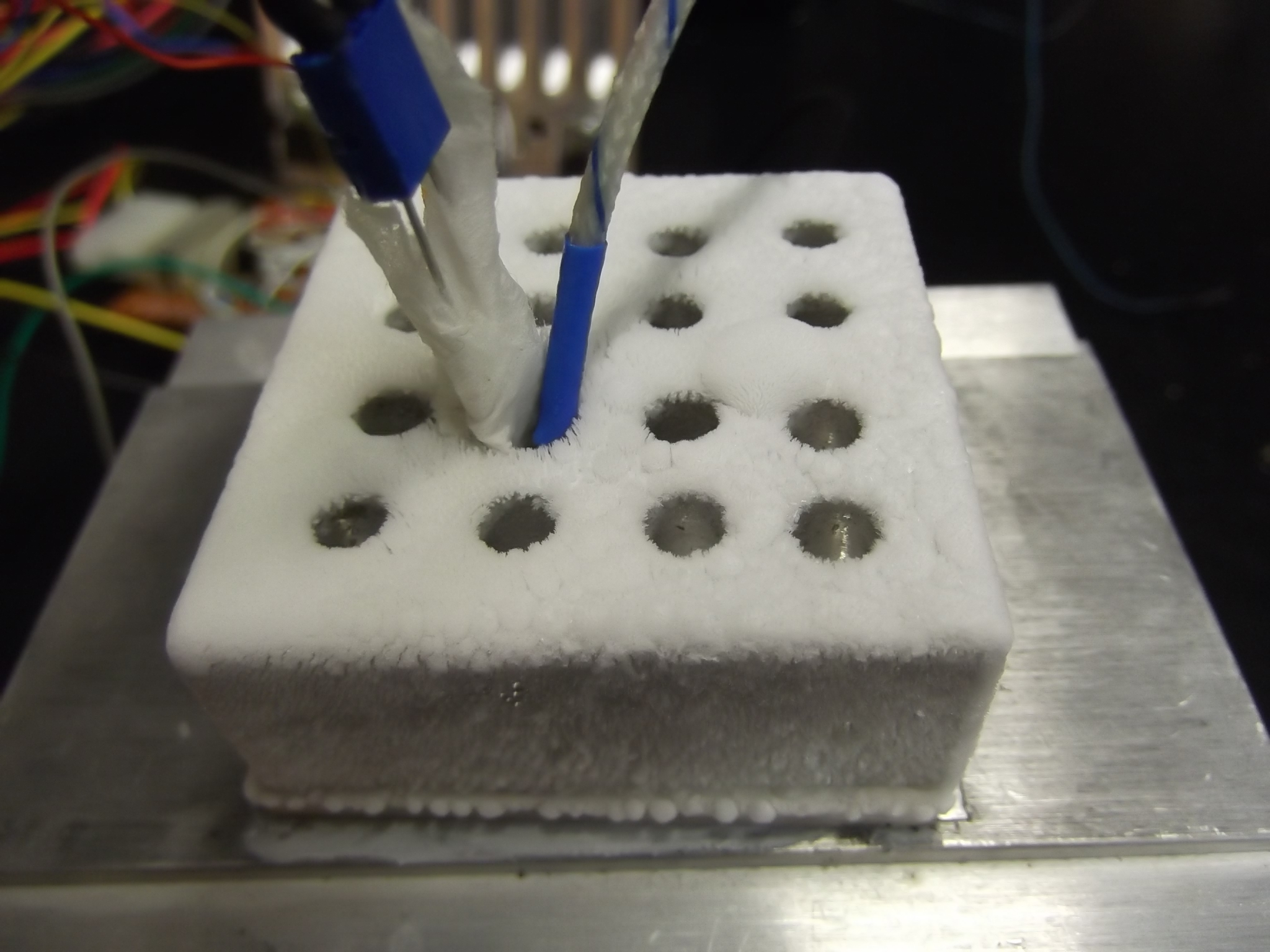Team:Paris Saclay/PS-PCR/detailed description
From 2013.igem.org
| Line 41: | Line 41: | ||
|- | |- | ||
|} | |} | ||
| + | |||
== Design overview == | == Design overview == | ||
| - | + | TODO inclure schema | |
| - | |||
=== Solid state heating/cooling === | === Solid state heating/cooling === | ||
| + | |||
| + | [[File:Pssnow.jpg|thumb|Testing the cooling power]] | ||
By using a [http://en.wikipedia.org/wiki/Peltier_effect#Peltier_effect peltier thermoelectric device], the system achieves fast heating and compressor-less cooling, enabling it to reach temperatures ranging from -3°C to 120°C in a relatively short time. | By using a [http://en.wikipedia.org/wiki/Peltier_effect#Peltier_effect peltier thermoelectric device], the system achieves fast heating and compressor-less cooling, enabling it to reach temperatures ranging from -3°C to 120°C in a relatively short time. | ||
| - | When powered, the peltier block transfers heat from one of its sides to the other, thus cooling the former while heating the latter. The "heat pumping" direction can be flipped by | + | When powered, the peltier block transfers heat from one of its sides to the other, thus cooling the former while heating the latter. The "heat pumping" direction can be flipped by reversing the direction of the current in the device. |
| - | + | One side of the peltier is thermally attached to the sample holding aluminum block, while the other is attached to a computer CPU fan-thermalized radiator. | |
| + | <div style="clear:both;"></div> | ||
| + | |||
| + | |||
| + | |||
| + | === Power control === | ||
| + | |||
| + | In order to control the current inside the peltier, and therefore the heating/cooling power, a | ||
== Construction == | == Construction == | ||
| + | |||
| + | === Tolerant design === | ||
| + | |||
| + | The PSPCR cycler uses a novel approach for DIY construction : part tolerance. Indeed, the system has the unique property of being tolerant to reasonable component variations. This lets users choose parts they may already have, or that they can get more easily. | ||
| + | |||
{{Team:Paris_Saclay/incl_fin}} | {{Team:Paris_Saclay/incl_fin}} | ||
Revision as of 22:49, 16 September 2013
Contents |
PSPCR
The Paris-Saclay open source PCR thermal cycler project.
Introduction
PCR (Polymerase Chain Reaction) is a very useful procedure in the field of synthetic biology. However, this technique requires a device called a thermal cycler, which is designed to cycle the samples through different temperature steps. Commercial PCR thermal cyclers are traditionally very expensive, with prices starting at $2000, which makes them hard to afford for small labs and DIY projects.
This project aims at creating a thermal cycler for under 30€ with easily accessible parts.
Comparison with other open source projects
Some open source PCR thermal cycler projects already exist, but the aim of the PSPCR project is to provide a better and more affordable system, thus filling a gap in the list of existing projects.
| Project | Price | Discussion |
|---|---|---|
| [http://openpcr.org/ OpenPCR] | $649 | Heated lid, good performance, hard to manufacture. |
| [http://www.instructables.com/id/Arduino-PCR-thermal-cycler-for-under-85/ Arduino PCR] | $85 | No heated lid, room for only 2 tubes, fan-only cooling. |
| [http://lavaamp.wordpress.com/ Lava-Amp] | "pennies" | No data available, probably slow with no heated lid. |
| [http://www.instructables.com/id/Coffee-Cup-PCR-Thermocycler-costing-under-350/ Coffee Cup PCR] | $350 | 7 slots, no heated lid, fan-only cooling. |
| PSPCR | Under 30€ | Fast solid state heating/cooling, 16 slots, heated lid. |
Design overview
TODO inclure schema
Solid state heating/cooling
By using a [http://en.wikipedia.org/wiki/Peltier_effect#Peltier_effect peltier thermoelectric device], the system achieves fast heating and compressor-less cooling, enabling it to reach temperatures ranging from -3°C to 120°C in a relatively short time.
When powered, the peltier block transfers heat from one of its sides to the other, thus cooling the former while heating the latter. The "heat pumping" direction can be flipped by reversing the direction of the current in the device.
One side of the peltier is thermally attached to the sample holding aluminum block, while the other is attached to a computer CPU fan-thermalized radiator.
Power control
In order to control the current inside the peltier, and therefore the heating/cooling power, a
Construction
Tolerant design
The PSPCR cycler uses a novel approach for DIY construction : part tolerance. Indeed, the system has the unique property of being tolerant to reasonable component variations. This lets users choose parts they may already have, or that they can get more easily.
 "
"
